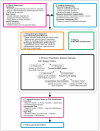Comprehensive Review of Endometrial Cancer: New Molecular and FIGO Classification and Recent Treatment Changes
- PMID: 40004914
- PMCID: PMC11856752
- DOI: 10.3390/jcm14041385
Comprehensive Review of Endometrial Cancer: New Molecular and FIGO Classification and Recent Treatment Changes
Abstract
Endometrial cancer (EC) is the most common gynecologic malignancy in developed countries, with rising incidence due to aging populations and obesity-related factors. This review explores the evolving molecular and FIGO classifications of EC, highlighting their significance in diagnosis, prognosis, and personalized treatment strategies. Molecular subtyping based on The Cancer Genome Atlas (TCGA) classification offers a more precise understanding of EC, dividing it into POLE ultramutated, microsatellite instability-high (MSI-H), copy-number low (CNL), and copy-number high (CNH) subtypes. Each subgroup has distinct genetic, histological, and prognostic characteristics. Recent updates to the FIGO staging system incorporate molecular features, allowing for more tailored treatment approaches. Advances in immunotherapy, targeted therapies, and novel therapeutic combinations have reshaped clinical management. This review emphasizes the integration of molecular diagnostics into routine practice, outlining challenges and future perspectives in managing EC for improved patient outcomes.
Keywords: FIGO classification; POLE ultramutated; The Cancer Genome Atlas (TCGA); copy-number high (CNH); copy-number low (CNL); endometrial cancer; immunotherapy; microsatellite instability-high (MSI-H); molecular classification; personalized medicine; targeted therapies.
Conflict of interest statement
The authors declare no conflicts of interest.
References
-
- Wedin M., Stålberg K., Marcickiewicz J., Ahlner E., Åkesson Å., Lindahl G., Kjølhede P., LASEC Study Group Incidence of lymphedema in the lower limbs and lymphocyst formation within one year of surgery for endometrial cancer: A prospective longitudinal multicenter study. Gynecol. Oncol. 2020;159:201–208. doi: 10.1016/j.ygyno.2020.07.014. - DOI - PubMed
Publication types
LinkOut - more resources
Full Text Sources


